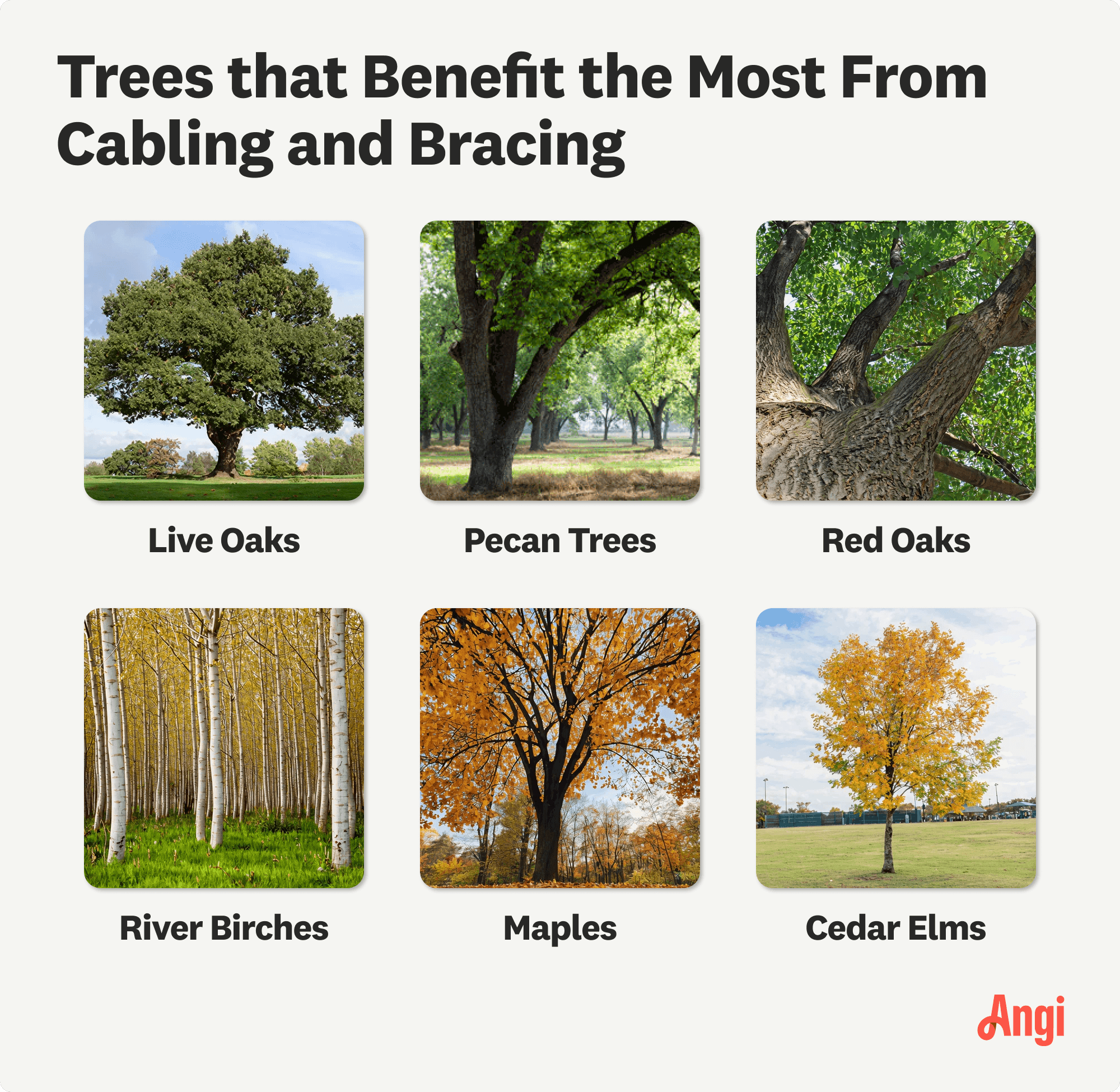Get transparent shrub removal cost info. Learn average prices, key cost factors, and tips to save on your next shrub removal project.
What Is Tree Cabling and Bracing?
Cabling and bracing might save your favorite tree


Cabling and bracing can provide support to weak or vulnerable trees by offering stability and redistributing stress.
While commonly used for V-shaped trees, cracking trees, and storm-damaged trees, cabling and bracing won't necessarily be effective when a tree is falling due to root issues or a decayed trunk.
Due to the risk involved with handling unstable or compromised trees, only a trained tree professional should apply cabling and bracing.
Not every tree is a goner just because it's showing signs of stress or damage. Many homeowners use a method called tree cabling and bracing to support struggling trees. What is tree cabling and bracing? This proactive method redistributes weight and stress to help enhance a tree's longevity and make your property safer. However, it should only be performed by a tree specialist or a specially trained arborist. Here's what you need to know.
What Is Tree Cabling and Bracing, and How Is It Used?
Cabling and bracing trees involve two different techniques. Cabling involves using flexible cables between branches to redistribute weight and stress. Meanwhile, bracing involves using rigid rods to provide mechanical support that strengthens weak spots and preserves a tree's structure.
Ideally, bracing and cabling will reduce risks for structural failure by stabilizing a tree or limiting the movement of branches and stems with loose attachments. The overarching goal is to redistribute stress across a tree and prevent movement that leads to weakening or breakage. In addition to saving a beloved tree that is an important element of your home's landscaping, cabling and bracing can prevent injuries and damage caused by falling limbs that could potentially land on people, pets, your home, your deck, your fence, or another structure on your property.
Trees often require cabling and bracing to survive after extreme weather weakens branches or limbs. Heavy snow and hurricane winds are the most common reasons for this at different times of year.
How Long Will Results From Tree Cabling and Bracing Last?

When support cables and anchors used for tree stabilization are properly installed, they will generally stay in place to provide support and correction for 25 to 50 years. While very little maintenance is required, it's important to have all hardware and wood anchors inspected for weakening or corrosion every few years. In addition, professional tree trimming costs should be considered an investment in a tree's ongoing health and prevention against excess weight after you've utilized cabling and bracing.

When to Cable and Brace Trees
If a tree on your property is raising concerns, it's best to have a licensed local tree expert or arborist assess its health and integrity. Here's a look at the telltale signs that a tree may require an intervention using cabling and bracing to survive:
Leaning: While leaning is sometimes "harmless" because it's caused by a natural growth pattern or a tree's inclination to lean toward the sun, severe leaning that increases a tree's risk of falling should be corrected. In addition to cabling and bracing, installing stakes and replanting a tree are often recommended as techniques for how to straighten a tree that’s leaning
Storm damage: This is the most common reason for cabling and bracing. Following storm damage, support can help to save loose, cracked, or falling limbs to help the tree heal.
Cracks or weak spots: Noticeable cracking or splitting may be fixable.
V-shaped growth: When a tree has a growth pattern with two large stems that represent V-shaped growth from the trunk, support can keep it resilient against splitting. Arborists refer to this growth pattern as a tree having codominant stems.
A local tree maintenance pro near you can visit your property to diagnose a problem tree. While all trees should be handled with care, a tree that has recently sustained storm damage or a lightning strike should be treated as a fall risk. Avoid going near the tree until you can have it looked at by a pro.
The homeowners guide to tree services
From average costs to expert advice, get all the answers you need to get your job done.
- •
 •
•Get a clear estimate of palm tree maintenance cost, including trimming, fertilization, and pest control, so you can keep your palms healthy and your budget on track.

The cost to remove palm trees depends on several factors, including their size, location, and more. Our guide shows the average palm tree removal costs.

You don’t have to hire a professional to eliminate a tree stump. Save money and learn how to rot a tree stump quickly using these methods.

If you’ve hired a tree service to trim your trees or remove them, you’ll have to decide whether to tip the pros afterward. Learn more about your options.

Plumb trees are great for small yards, but they require maintenance as they grow. This guide will show you how to prune a plum tree, no matter the age.

